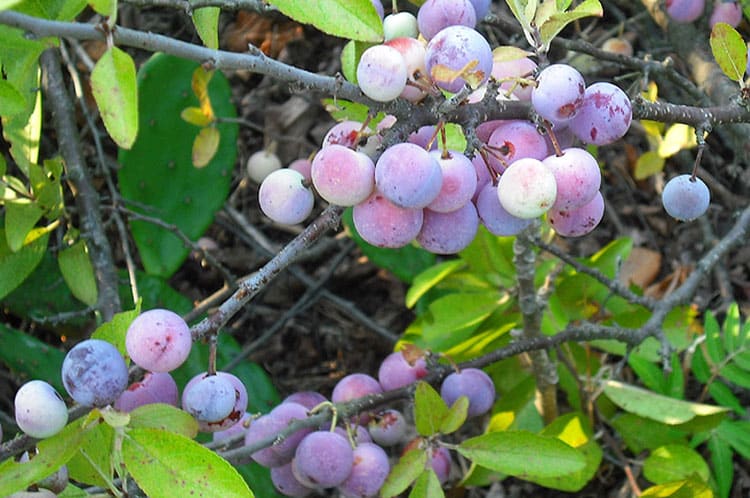
I finally got to do something quintessentially ”Nantuckety” today for the first time in the eleven years that I have lived here, namely pick beach plums. I stumbled upon a bush laden with purple fruit and was delighted to have the time and a container handy so that I could pick some for a batch of jelly. The Latin name for the beach plum plant is Prunus maritima Marshall which was discovered and named by plant taxonomist Humphrey Marshall in 1785. Maritima is an obvious reference to its abundance along the seashore. Prunus places it in a large genus that includes peaches, cherries, almonds and prunes. North American’s indigenous population enjoyed them as did the colonists who noticed it almost immediately upon reaching the shores of the New World. Early explorers of the New York area, including Giovanni da Verrazano (earliest written record in 1524) and Henry Hudson, mentioned beach plums in their writings.
The beach plum is a wild, native plum that grows in abundance on the sandy shores and coastal plains from Maryland to Maine. It is very abundant on the New Jersey Shore, Cape Cod, and the islands of Martha’s Vineyard and Nantucket. The fruit can be consumed right off the bush or tree as I happily confirmed, but is commonly used for the making of jam and jelly. The skin can be quite tart. P. Maritima is a member of the rose family which includes about 2000 species of trees, shrubs, and herbs worldwide. Other family members include serviceberries, hawthorns, apples, plums and cherries. The United States Department of Agriculture’s http://plants.usda.gov/core/profile?symbol=PRMA2 web page shows us that the range for Prunus maritima Marshall is limited to the northeast from Maryland to Maine in every state in that region except Vermont which is not known for their beaches. There is some evidence it is trying to sneak into Virginia.
We don’t really have much in the way of beach plums here at the Field Station and people guard their favorite foraging spots with zeal. Beach plums love sandy soil and can tolerate a fair amount of salt air. They look somewhat straggly with alternate, elliptical leaves (3–7 cm long and 2–4 cm wide with sharply serrated edges) that are green on top and paler underneath. The leaves turn a beautiful fire engine red in the fall. Beach plums are deciduous shrubs that grow slowly along the shore topping out at only 1–2 meters (3-6 feet) in height. Further inland they may get to be up to 4 meters (12 feet) tall, especially when cultivated in gardens. The flowers are small but showy, 1-1.5 cm in diameter, with five white petals and large yellow anthers. The fruit is an edible drupe 1.5–2 cm diameter in size. The plant is very cold hardy and prefers full sun and well-drained sandy soil. It spreads roots by putting out suckers but in coarse soil puts down a tap root. In dunes it is often partly buried in drifting sand. It blooms in mid-May and June. The fruit ripens in August and early September. Fertilization and pH adjustments greatly increases fruit yield over time http://www.redorbit.com/news/science/915360/cultural_methods_for_beach_plum_prunus_maritima_fruit_production/ retrieved August 31st 2014.
According to Wikipedia (http://en.wikipedia.org/wiki/Prunus_maritima retrieved August 31st 2014) “Plum Island, Massachusetts and Plum Island, New York are named after the Beach Plum; as are Plum Cove Beach in Lanesville, Gloucester, Massachusetts; and Beach Plum Island (State Park) in Sussex County, Delaware.” Cornell University and several farms across the North East and as close as Cape Cod received a sustainable agriculture grant from the USDA to create and support a cottage beach plum industry of artisan farms and small scale canners and growers (http://www.beachplum.cornell.edu/) . This is an excellent idea for Nantucket as long as we can control and recycle fertilizers used to increase fruit yield.
And in the “not only good for breakfast” category, we can use beach plums to maintain dunes and dune fields. Some communities that once had to remove beach plums from seashores to build parking lots are reconsidering the natural ability for the plants to hold sand and survive storms and are replanting them in areas prone to accelerated erosion. P. Maritima is native to our shores unlike rosa rugosa and can push up through sand piled on top of them. It grows alongside other common beach plants such as beach grass (Ammophila breviligulata), beach pea (Lathyrus japonicas), and seaside goldenrod (Solidago sempervirens).
Seashore development and the “good year, bad year” unpredictability of beach plum harvests are two issues that have long made it difficult for beach plums to reach a steady cultivar stature. I found many papers on the difficulties encountered while taming wild beach plums which allude to their inconsistent nature that makes them such hardy survivors but somewhat unreliable domesticated plants.
Beach plums also are high in cancer fighting antioxidants and may work as well as their cousins the cranberries in fighting urinary tract infections. If jams and jellies aren’t your thing, you can try beach plum wine or gin. Natali Vineyards in Goshen New Jersey produces a 100% beach plum wine. For more information, visit www.natalivineyards.com. In the mood for something with a bit more bite? Beach plum gin is a popular product only available at Greenhook Ginsmiths which is based in Greenpoint, Brooklyn (http://www.nytimes.com/2012/07/04/dining/a-plummy-gin-from-brooklyn.html?_r=0). And drinking your antioxidants in a tasty alcoholic mixture is nothing new! This article enlightening me by describing early cultivation attempts by colonists who used beach plums to make a frothy alcoholic drink called syllabub (which as a base used many types of sweet wines) http://www.jstor.org/discover/10.1525/GFC.2012.12.3.21?uid=3739696&uid=2&uid=4&uid=3739256&sid=21104109410501
By the way, my secret spot, was actually in a relatively interior part of the island at least a mile or more from the ocean. Where, you ask, I’ll never tell. I have been given a few jars of spectacular beach plum jam and jelly over the years and I’ve been told to include plums of various degrees of ripeness in order to take advantage of natural pectin in the fruit. There are many sites online with easy recipes including this article link on NPR http://www.npr.org/template.s/story/story.php?storyId=112560982
Check out the University of Maryland’s extension program fact sheet to learn how to transplant and grow beach plums: https://extension.umd.edu/smallfruit/tree-fruit/plum retrieved August 31st 2014. I really enjoyed this article entitled “Taming the Wild beach Plum written by Richard Uva who is the manager of the beach plum sustainable agriculture project in the Horticulture Department at Cornell University he is Interpretation and the Coordinator at Cornell Plantations—the botanical garden, arboretum, and natural areas of Cornell University.http://www.beachplum.cornell.edu/tamingthewildbeachplum.pdf, From his article I learned that Edgar Anderson, a geneticist at the Arnold Arboretum and Oliver Ames (son of Oakes Ames who was the head of the Arboretum) a pilot decided to map Prunus Maritima from the air up and down the Massachusetts coast in the springtime while they were blooming and published their work in 1932 as inaugural “Botanizing from an Airplane”! Anderson had resorted to this unusual method as he was having a dickens of a time finding the plants otherwise, something I can certainly sympathize with.
To learn more about how communities in New Jersey are using beach plums to reduce coastal erosion, go to http://www.shorenewstoday.com/snt/news/index.php/regional/127-act-naturally-/5329-act-naturally-g-to-save-coastal-dunes-heres-a-plum-good-idea.html
In the mood for a historic syllabub? Head to http://www.historicfood.com/Syllabub%20Recipes.htm for some recipes and historical notes and errata. Maybe we should have some jam at my annual Friends of the Field Station meeting scheduled for 5:00 pm on Sunday September 7th (open to the public, I’ll be speaking). Hope to see you there and happy beach plum picking!


